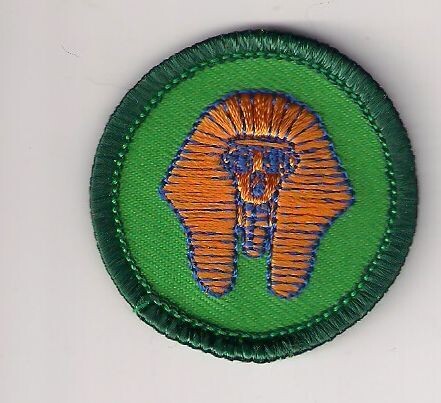Archeology Va Skyline Council own Junior Badge (Original)
Requirements
Complete six activities.
Read a book on archaeology. Ask your librarian to help you find one that interests you. Find out why archaeologists search for artifacts and what tools are used in their work.
Read an article about an archaeology site in a magazine such as National Geographic, Archaeology, or Smithsonian. Prepare your own site report including the following information: location, archaeologists working on the site, questions they were trying to answer, what they found, and questions yet to be answered.
Read about the different types of archaeology/archaeologists and choose one to report on to your troop. Examples are historical, prehistoric, classical, underwater, landscape, paleontology, urban, and zooarchaeology.
Interview an archaeologist to find out about the educational requirements and other considerations of this job. If possible, visit the place where the archaeologist works or invite her or him to speak at a troop meeting.
Contact your stateʼs historic resource department and ask about the laws in your state that are designed to protect archaeological sites. Find out what a “pot hunter” is and how they can be dangerous to archaeological sites.
If possible, ask to volunteer at a site and keep a diary of your experiences.
With permission, visit an old building or the site of an old building (for example, a barn, house, or church). Take pictures and do a surface survey of the site. If you find any artifacts on the surface, make a map and record where you found them. Also make a list of the artifacts and what they can tell you about the site. Then send the information to a local archaeologist or the state historic resource department.
Plan your own “dig” on paper. Include the tools you would need, where you would dig and why, who would be on your crew, and what would happen to the artifacts you might uncover.
Prepare a site map of your bedroom. Then prepare an artifact display showing some of the items discovered in your room. Share this with your troop. Explain what the artifacts tell about the person who lives in this room.
Pretend that you are an archaeologist living in the year 5,000 and that you have just found a silver coin (a nickel). Assume that you have never seen the coin before, that you have heard of the United States, and that you know nothing at all about the people who made this coin. Pretend that the coin is an artifact that was found on a site where people lived thousands of years ago and that this is the only source of information available about these people. As an archaeologist, briefly describe these people and their ways of living based on information found on the coin. Use your imagination.
Visit a museum/historic house and look at the artifacts they have found. Share what you learn with your troop.
Contact the historic resource department to find out what sites near your town are open to the public for tours. If possible, visit one or more sites with your troop or family.
Prepare an imaginary site in an aquarium or large jar. Show different soil layers and a variety of artifacts.
Pretend that your troop is preparing a time capsule to be opened in a hundred years. What objects or artifacts would you include that typify our society and may not be around in that time?
